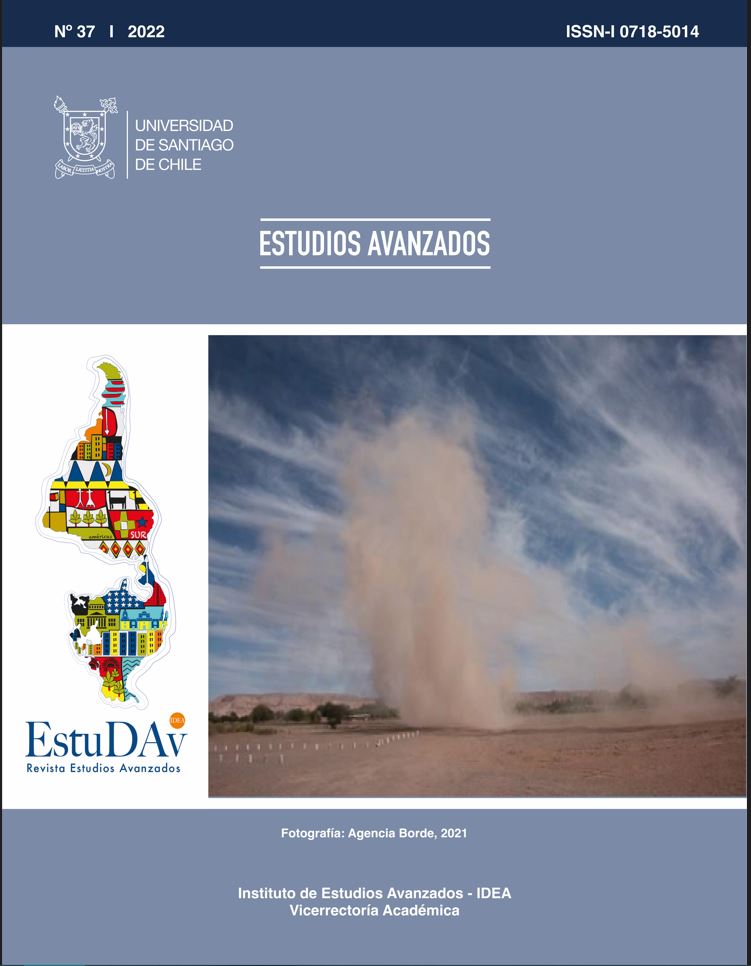Paisaje, cuerpo y tiempo: la presencia y la mirada incorpórea en la obra de Agencia de Borde
DOI:
https://doi.org/10.35588/estudav.v0i37.5904Palabras clave:
paisaje, cuerpo, tiempo, presencia, dronesResumen
Analizaremos las estrategias con que el colectivo chileno Agencia de Borde desarrolló Una explosión sorda y grave, no muy lejos del año 2017, una instalación perteneciente al proyecto Campos Minados, para problematizar la relación paisaje-técnica-representación. La obra se basa en la exploración de los campos minados sembrados entre los años 1973 y 1983 en el Desierto de Atacama. Un territorio intocable, fuera de circulación, que ante su devenir explosivo acaece efímero e imaginado, en el cual un dron y su ojo digital aparece como única posibilidad de acceder visualmente a lugares inadmisibles. Bajo dichas condiciones, la anulación del territorio y su imposibilidad de habitarlo, el texto se enfoca desde dos aristas: por un lado, en la problematización de los conceptos de paisaje, presencia y escucha. Y por otro, pensar en la desaparición del cuerpo ante la experiencia medida del registro del ojo maquínico y digital del dron. De esta manera, ante el efecto salvaje que las ambiciones militares han ejercido sobre los lugares, el análisis propone pensar la tensión presente en la representación de los territorios a través de prácticas creativas contemporáneas.
Descargas
Referencias
Agencia de Borde (2021). Border Agendy Art Collective. En https://borderagency.net/ (consultado 28/12/2022).
____. (2020). ¿Y si no se puede confiar en el suelo bajo tus pies? Santiago, Santiago, Ministerio de las Culturas, las Artes y el Patrimonio, Gobierno de Chile.
____. (2019). The Landmine Project. Santiago, Ministerio de las Culturas, las Artes y el Patrimonio, Gobierno de Chile. En https://www.thelandmineproject.com/ (consultado 28/12/2022).
Allen, J. (2010). “That Eye, The Sky”. En Frieze, 01 de junio de 2010. En from https://www.frieze.com/article/eye-sky (consultado 28/12/2022).
Andermann, J. (2018). Tierras en trance: arte y naturaleza despueÌs del paisaje. Santiago, Metales Pesados.
Bourriaud, N. y Mattoni, S. (2014). PostproduccioÌn: la cultura como escenario, modos en que el arte reprograma el mundo contemporaÌneo. Buenos Aires, Adriana Hidalgo.
Chamayou, G. (2016). TeoriÌa del dron. Barcelona, Ned.
Crary, J. (2008). Las técnicas del observador: Visión y Modernidad en el siglo XIX. Murcia, Cendeac.
De Certeau, M.D.; Giard, L. y Mayol, P. (2010). La invención de lo cotidiano. Ciudad de México, Universidad Iberoamericana.
Emmelhainz, I. (2015). “Conditions of Visuality Under the Anthropocene and Images of the Anthropocene to Come”. E-flux Journal 26. En https://www.e-flux.com/journal/63/60882/conditions-of-visuality-under-the-anthropocene-and-images-of-the-anthropocene-to-come/
Fischer-Lichte, E. (2017). “Sobre la producción performativa de la materialidad”. En Fischer-Lichte, E. EsteÌtica de lo performativo. Madrid, Abada.
Goffard, N. (2019). Intramuros palimpsestos sobre arte y paisaje. Santiago, Metales Pesados.
Groys, B. y Rocca, C.P. (2018). Volverse puÌblico: las transformaciones del arte en el ágora contemporaÌnea. Buenos Aires, Caja Negra.
Hensley, N. (2016). “Drone Form: Word and Image at the End of Empire”. E-flux Journal 72. En https://www.e-flux.com/journal/72/60482/drone-form-word-and-image-at-the-end-of-empire/ (consultado 28/12/2022).
Hernández, M. (2020). “Contratiempos del Arte Contemporáneo”. En Hernández, M. El arte a contratiempo. Madrid, Akal: 16-28.
Hui, Y. (2017). “¿Qué es un objeto digital?”. Virtualis 7(15): 81-96.
Jamenson, F. (2003). “The End of Temporality”. Critical Inquiry 19: 695-718.
____. (2011). El posmodernismo o la loÌgica cultural del Capitalismo Avanzado. Barcelona, PaidoÌs.
Lyotard, J. (1998). “El tiempo, hoy”. En Lyotard, J. Lo inhumano. Charlas sobre el tiempo. Buenos Aires, Manantial: 65-83.
Maderuelo, J. (2005). El paisaje: geÌnesis de un concepto. Madrid, Abada.
Mbembe, A. y Beneduce, R. (2016). Necropolítica. Verona, Ombre Corte.
Mitchell, T.W. (2009). Landscape and Power. Chicago, University of Chicago Press.
Montero, M.; Salas, P. y Melo, S. (2018). “The Landmine Project: How to Cross a Fractured Territory”. International Journal of Culture and History 4(4): 84-87. DOI https://doi.org/10.18178/ijch.2018.4.4.127
Nancy, J.L. (2013). “Cuerpo-Teatro. El cuerpo como escena”. En Nancy, J.L. La particioÌn de las artes. Valencia, Universidad PoliteÌcnica de Valencia.
____. (2005). “Uncanny Landscape”. En Nancy, J.L. The Ground of the Image. Nueva York, Fordham University Press: 51-62.
____. (2008). Las musas. Buenos Aires, Amorrortu.
Parks, L. (2007). “Orbital Performers and Satellite Translators: Media Art in the Age of Ionospheric Exchange”. Quarterly Review of Film and Video 24: 207-216. DOI https://doi.org/10.1080/10509200500486288
Ramos Torres, R. (2014). “AtemporalizacioÌn y presentificacioÌn del mundo social en la sociologiÌa contemporaÌnea”. PoliÌtica y Sociedad 51(1): 147-176.
Roger, A.; Maderuelo, J. y Veuthey, M. (2013). Breve tratado del paisaje. Madrid, Biblioteca Nueva.
Rojas, S. (2021). “El arte en la frontera del Posthumanismo”. Revista [cuatrotreintaitrés] 04: 3-7.
____. (2018). Campos minados: paisajes de un planeta deshabitado. En https://sergiorojas.cl/wp-content/uploads/2020/05/Campos-Minados-1.pdf (consultado 28/12/2022).
____. (2012). El arte agotado. Santiago, SangriÌa.
Seel, M. y Restrepo, P.S. (2010). EsteÌtica del aparecer. Buenos Aires y Madrid, Katz.
Stahl, R. (2013). “What the Drone Saw: The Cultural Optics of the Unmanned War”. Australian Journal of International Affairs 67: 659-674. DOI https://doi.org/10.1080/10357718.2013.817526
Steyerl, H. (2011). “In Free Fall: A Thought Experiment on Vertical Perspective”. E-flux 24. En https://www.e-flux.com/journal/24/67860/in-free-fall-a-thought-experiment-on-vertical-perspective/ (consultado 28/12/2022).
Steyerl, H.; Berardi, F. y ExpoÌsito, M. (2014). Los condenados de la pantalla. Buenos Aires, Caja Negra.
Vara Sánchez, C. (2015). “De la presencia como lo irreductible en la experiencia estética”. TALES. Revista de Filosofía 5: 340-352.
Vaskes Santches, I. (2011). “Posmodernidad estética de Frederick Jameson: pastiche y esquizofrenia”. Praxis Filosófica 33: 53-74. DOI https://doi.org/10.25100/pfilosofica.v0i33.3404
Weizman, E. (2002). “1. Introduction to The Politics of Verticality”. Open Democracy, 23 de abril 2022. En https://www.opendemocracy.net/en/article_801jsp/ (consultado 28/12/2022).
Descargas
Enviado
2022-12-02Publicado
Número
Sección
Licencia
Derechos de autor 2023 Carla Ayala Valdes

Esta obra está bajo una licencia internacional Creative Commons Atribución 4.0.










